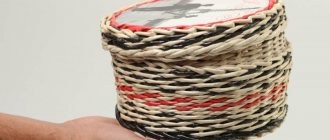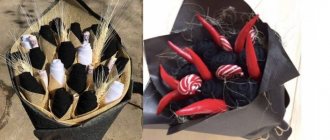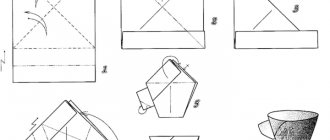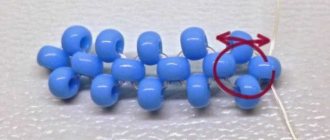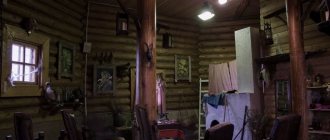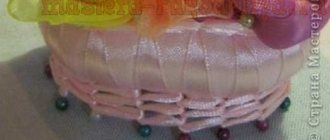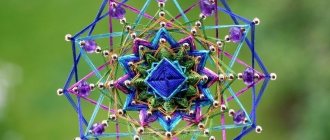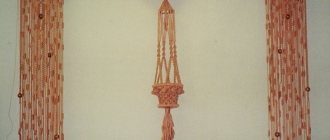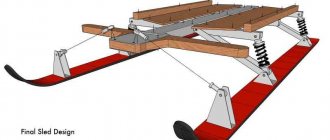Reed weaving is the oldest handicraft known today. The art of pottery began with it, namely, the first pots and bowls were created from twisted stalks of reeds, which were coated with clay. For beginning needlewomen, the cheapness and availability of material for work is very important. Reed is an ideal plant for weaving, because it can be found in any damp place and prepared without special skills. To weave reeds for beginners, you need to know some subtleties about this material and its preparation for the product. Having studied this type of craft in detail, you will know how to weave a fence, a mat and many other interesting things.
Decoration methods
A fence made using this material is itself a very decorative and original structure. In order to make your fence more unusual and give the structure a characteristic rustic atmosphere, you need imagination and various additional elements. These are various figurines using wicker, pottery, and cart wheels. The flowers look especially beautiful. They can be planted along the fence or planted in wicker pots.
Beginning needlewomen and craftsmen are faced with the problem of material. At first it is difficult to decide what kind and nature of crafts you want to build. Then the question arises of what material to use and how to work with it correctly. Therefore, you should study the topic of future crafts in advance and make a choice. To weave from reeds, you need to know some subtleties about preparing reeds for a product for beginners. After studying the details of this matter, you will know how to weave a fence, mat and any other things from reeds and cattails.
There is nothing difficult when choosing any weaving technique. It is important to know the basics of some knots, patterns, or the basics of constructing structures in order to simply start working with crafts using one or another weaving technique with your own hands.
By choosing reeds as the basis for crafts, you can easily build not only baskets and hats, but even slippers. The world of crafts made from this material is very diverse, so don’t even think about them, but start doing them. Numerous master classes and schemes for performing work are not uncommon for modern needlewomen and craftsmen.
Looking at beautiful wicker baskets, hats and accessories, we admire the skill of their creators. Humanity has not reached unprecedented heights in weaving from cattails and reeds in one day - the art of weaving is more than 8.5 thousand years old.
Read also: How to make an airplane out of cardboard
Our ancestors began weaving containers and baskets much earlier than making ceramic and fabric things. Boxes, containers and vases made of plastic, metal or paper, which we use to this day in everyday life for storing and transporting various household items, were made of reeds and cattail leaves in those distant times.
The first wicker baskets appeared in the Middle East and Africa eight and a half thousand years ago. Later, judging by the finds in excavations of old civilizations, in Egypt, they are more than 5 thousand years old. An interesting fact should be noted: the method of weaving baskets has not undergone fundamental changes over thousands of years. The baskets that are still woven in Egypt are not much different from the finds of archaeologists.
Wicker baskets appeared on European territory much later: in the area of the town of Glastonberry, in the UK, a rare basket was found, which, according to experts, is about two thousand years old.
In those ancient times, human life was unthinkable without wickerwork from the very moment of birth to death. The mother rocked the newborn baby in a cradle made of grass, the human bed was nothing more than a mat - a woven rug, and was escorted to the other world in a coffin woven from willow twigs.
This master class was created to teach you how to use simple little things to create crafts. Here you will find photos, diagrams and videos on making items from reeds. You will learn a lot of new and useful information.
Mat
If you are a beginner in this craft, you should first try weaving a reed mat. This product does not require anything special, including a lot of practice in weaving. You will need twine, reeds and a little patience. In return, you will receive an interesting, original item and master weaving skills.
The amount of harvested reeds depends on the size of the mat. For a meter of mat you need to use a roll of twine, 4 slats and screws.
Let's prepare a place to work.
Preparing material for work
You are almost ready to weave a reed mat, but you also need to prepare the material. To do this, dried reed leaves need to be soaked for a few minutes in a trough or bath. They need to be wetted so they don't break. After 5-7 minutes, remove the reeds from the water and wrap them in gauze or cloth so that excess moisture quickly drains away. Leave the material for several hours. Just do not overexpose the reeds in water, otherwise after the product is ready, the reeds will dry out and shrink.
After 2-3 hours you can start weaving.
Construction of a fence
A do-it-yourself reed fence is built in several stages:
- Cutting and drying reeds.
- Making mats.
- Direct construction of the fence.
Harvesting reeds begins in the fall - in September-October. The plant can be mowed or cut with a sickle at the very base.
You should immediately clean it of leaves and fluff and carefully tie it into small bundles.
You can clean the reed with a homemade brush. To make it, hammer long nails into the plank in several rows at a distance of 1.5 cm.
Find a place to dry the prepared reed bundles.
note
: the color of the future fence depends on where you dry the reeds: a plant dried in the shade is green, in the sun it is yellow.
The size of the mats, easy to install, is 2 m in length and 10 cm in thickness. The height depends on the prepared raw materials and your desires.
Collection and preparation
Material collection occurs from August to October. It is important to cut the selected plant species directly from the water. Plants from a dry bank will be fragile and brittle. The most convenient way to cut plants is from a boat using a long-handled sickle or by climbing into the water in wading boots.
The stems are tied into small sheaves and dried in a vertical position, preferably in the shade. But you can also do it in the sun. The type of drying affects the color of the plants: in the sun they become lighter and more golden.
It is best to store the prepared material outdoors under a canopy or in the attic in a horizontal position. It is important not to store them in plastic bags. This leads to the formation of mold.
Before starting work, it is recommended to soak the required number of stems and leaves in water.
But if the material is collected in the right, damp place, it is enough to simply spray them with water. And also, if necessary, you should spray them periodically during work. The plants themselves will indicate that this needs to be done when they begin to crack slightly when bent.
Features of work
A reed fence is a natural and quite original fencing.
We start with preparing the material. Reed grows almost everywhere near rivers and is harvested in September-October. During this period, the plant reaches its optimal height, which is important when constructing a fence. Before you start weaving, you need to make a simple workbench for making mats.
The length of your table should match the height of the future fence. We spread the material on the table in a thick layer ranging from 15 to 20 cm. Then we lay boards on it, with the help of which the plant stems are fixed. Next we perform the firmware.
It is very similar to the firmware of a regular broom.
Before making a wicker fence from reeds, you should think about the fastening system of the fence. You can use various materials, for example, wooden beams. But better and more reliable are metal poles or pipes. We attach the finished, stitched mats to the posts using wire. The fence must be treated with a special protective fire-fighting agent, since reeds, under certain conditions, flare up like a match.
There are various variations in manufacturing. For example, you can make a fence using alternate sections, as well as using branches and mats. An excellent option can be made using a mesh - chain-link.
Insulation with reed mats
Insulating walls with reeds is not difficult. The easiest way is to attach the slabs with nails to cross-bars pre-installed on the wall. There is another method: a frame is built from a thin wooden beam, reed slabs are placed in the openings and securely fixed and clamped.
Do-it-yourself weaving from reeds and reeds for beginners
Builder 4th category
It’s not at all difficult to master weaving techniques and learn how to create exclusive products from natural materials. Each stage of reed weaving is interesting and exciting: collecting and preparing material, mastering weaving techniques, creating exclusive products. It’s worth a try and perhaps it will become a real hobby or the basis of a business.
Workplace. Making a Simple Weaving Loom
To weave reeds you need a suitable place. Since weaving and weaving are time-consuming activities, you need a place under a canopy so that in case of rain the product will not be damaged.
A loom is also needed. To do this, make a frame from slats the width of the future mat. Mark parallel slats corresponding to the width of the desired product along the entire length in centimeters. Drive a nail or screw into each marking in a checkerboard pattern. Stretch the twine every second centimeter. There must be an even number of segments.
Northern and southern reeds
It is equally important to know what kind of reed is needed for weaving, because the plant from the southern part of our country is significantly different from its northern counterpart.
The one that comes from northern places is unsuitable for weaving, since its stems are covered with air chambers, rough, and lumpy. Because of this, the reed is inelastic, inflexible, and easily breaks with light pressure.
But southern reed is elastic and flexible, it does not allow moisture to pass through at all. Its trunk is filled with pulp, which is why the stem becomes elastic and does not break when pressed hard. This is a very dense material from which you can make luxurious products.
The surface of high-quality reeds suitable for weaving is smooth, shiny, and has a yellowish tint.
Peddig is produced from southern reeds - thin twigs 10 mm wide, 2 m long, no more than 1 mm thick. These thread-like twigs are very strong, elastic, and have a pleasant sunny color. They make beautiful baskets, furniture, and upholstery.
But how to prepare material for weaving from reeds?
Basic techniques
Any reed weaving workshop involves preparing stems and leaves using a sharp knife. The leaves are cut lengthwise into 3-4 parts. The stems are freed from small leaves.
The easiest way is to weave strips of leaves or stems at right angles. It is convenient to braid some solid base. This way, you can adjust the density of the weaving and make it easier to maintain proportions.
There are several basic reed weaving techniques for beginners:
- A bow is a method of weaving with one working stem around 2 warp stems. The working stem covers the stems of the base in turn with an S-shaped loop, moving along them. This weaving method is suitable for making voluminous products. You can weave not only lengthwise, but also in a circle. Weaving with a bow looks very impressive.
- Rope is a method of longitudinal weaving. This technique is ideal for making baskets because it requires vertical supports. Long stems intertwine with each other and with the stems of the vertical base.
Both techniques are easy to learn, but require practice.
Plasticine model
Plasticine reeds are made using a toothpick. To make the bush look prettier, it is better to cut them into different lengths. For one reed, twist two strands and flatten them. We make a large ball for the base of the plant; if you make it small, the reeds will fall.
Take a toothpick, coat it with green plasticine and stick it into the ball. We use brown plasticine to create a plant head on top, so that the edge of the toothpick protrudes from this part.
After this, we apply the leaves to the stem and press them to the center, and bend the edges a little. The wonderful reed for plasticine crafts is finished.
Making figures
Dry reeds are also suitable for creating various figures for kindergarten or school.
Animals
The basis of this reed painting must be prepared in advance. It can be printed on a printer and colored or drawn with gouache. You can decorate the craft only after the base has completely dried. To decorate a hedgehog figurine, you will need a small amount of reed inflorescences. The back of the animal is coated with glue. The reeds are glued to this part of the figurine in a chaotic manner. When the picture dries, the remains of the inflorescences must be removed from the picture.
Using the same principle, you can design a figurine of a fox, hare or wolf. This autumn applique will turn out very cute.
Birds
Another original craft on the theme “Autumn” that elementary school students can make is a three-dimensional reed duck. For work you will need the following materials:
- dry reeds;
- grass;
- glue and wire;
- threads;
- newspaper;
- plasticine;
- scissors;
- thick cardboard;
- sackcloth;
- plastic cover.
Step-by-step instructions for creating such a figurine with your own hands look quite simple.
- First, you need to make a blank from newspapers and threads. The body and head are connected using strong wire. The bird's neck is arched at the desired angle.
- Dry reeds need to be divided into segments. This must be done carefully so that future feathers do not fall off later.
- Each such detail must be carefully coated with glue and attached to a paper figurine.
- The bird decorated in this way should be left to dry overnight.
- The next morning, you need to sculpt a bird's beak from red plasticine. It is glued to the bird's head using a glue gun. You can make duck eyes in the same way.
- You need to cut out wings of the same size from a thick piece of cardboard and decorate these parts with reeds. Their wide part is attached to the body with glue.
- After this, you can begin to create a nest for this bird. The plastic lid of the bucket should be covered with burlap.
- The nest is decorated with dry grass or straw. The material is attached to the base using a glue gun.
- When the nest dries, you need to place the finished duckling inside.
How to make a fence and hedge from reeds with your own hands
A fence made of reeds is a very impressive fencing, which, if desired, can be made with your own hands. Such a fence can be practically free if there is a forest belt or pond nearby where this plant is abundant.
Appearance of a reed fence
Return to contents
Main characteristics and advantages of reeds
Reeds are ubiquitous and can be found near lakes, rivers, and wetlands. This plant is very unpretentious, grows quickly, occupying new territories, and grows to a considerable height during the season. The length of the reed stem can be higher than human height, so it is a very good material for constructing natural decorative garden fencing.
Option for the design and decoration of a reed fence
Since ancient times, reeds have been used as a building material for houses and other buildings. Residents of villages and fishing villages located along the banks of rivers built houses called “mosaics”. Sheaves of reeds were tied and coated with clay. Nowadays, this natural material has not lost its relevance, especially for lovers of traditions and fashion trends of ethno style. Reeds are used to make fences, walls, and cover roofs. Modern designers use this natural material to decorate and decorate the interior.
Among the advantages of reeds as a fence it is worth noting:
- environmental friendliness of natural material;
- the ability to humidify the air and bring coolness in extreme heat;
- excellent sound insulation properties;
- minimal costs for raw materials;
- protection from prying eyes;
- rodents and insects do not like to live in reeds - its bark contains a lot of calcium;
Ready-made reed sections for installing a fence
- simple installation that you can do yourself;
- naturalness and organic nature of the fence;
- fairly long service life;
- spectacular appearance.
You should also take into account the disadvantages of reed fencing:
- The main and significant disadvantage of a reed fence is its strong flammability. In dry weather, even a small spark or a thrown cigarette will cause the fence to flare up like a match. Treatment with fire retardants is mandatory, although this will significantly reduce the main advantage of the fence - environmental friendliness and increase its cost.
- A reed fence serves more of a decorative function. It will protect the area from animals and protect the yard from curious passers-by, but is not designed for heavy loads.
Regarding the durability of the fence, it is worth saying that the service life of the reed fence will depend on the configuration of the fence. If the stems of the reeds touch the ground, then in this place the fence will begin to quickly collapse.
An example of the design and fence posts of a reed fence
If the fence is raised, its service life can last several decades. Return to contents
Harvesting reeds
To make a wicker fence, reeds are harvested in the second half of August and September, after the leaves turn yellow. Reeds are also often cut in winter. Plants are mowed with a scythe, brush cutter or sickle at the very base of the stem. It is advisable to immediately lay the raw materials in neat bunches.
The reeds need to be cleared of leaves and fluff. It is better to do this on site so as not to bring garbage onto the site. To clean the stems, a special brush is used, which you can easily make with your own hands.
To do this, a row of nails is nailed through and through onto a wooden plank approximately 10 cm wide. The nails need to be long enough - from 7 cm, they are driven at a distance of 1 - 1.5 cm from each other. The sharp ends of the nails of this improvised comb are used for combing.
The process of harvesting reeds for installing a fence
Dry the reeds by tying them in small bundles or laying them out on a dry surface in natural conditions (not near heating devices or radiators). The color of the future fence will depend on the conditions in which the reeds were dried. In the sun, the stems will acquire a warm golden color; in the shade, the raw material will remain a light green hue.
With the onset of spring, when the raw materials are completely dry, you can begin building the fence.
Return to contents
Installation of a reed fence
The optimal size of a reed mat is: 2 m length and 10 cm thickness. There are several easy-to-do-it-yourself technologies for making reed fencing.
Return to contents
Making reed mats
Reed slabs produced on an industrial scale are highly valued - and their cost is not cheap. How to make high-quality fencing slabs from this free material with your own hands?
Making a simple machine
- A frame of the required size is made from timber.
- A series of pegs are driven inside the frame. The distance between the stakes will depend on the desired thickness of the mat - from 5 to 12 cm.
- Galvanized binding wire is laid between the stakes.
- The reeds are placed between the pegs in even bundles and wrapped with wire.
Making mats on a workbench
- A workbench table is made to fit the size of the mat, which can be made from simple boards. It is important that the surface is smooth. Gaps are left between the boards so that the binding wire can pass between them. This is what a machine for making reed mats looks like
- The reeds are laid in bunches on a table approximately 20 cm thick.
- A frame is placed on top to press the stems more tightly.
- The reeds are stitched with knitting wire in at least four places.
- After stitching, the ends are trimmed evenly on both sides.
The easiest way
- The reed stems are evenly laid on the wire.
- Another row of knitting wire is laid on top of the stems.
- The top and bottom wires are fastened with steel staples.
Another option
- The stems are tied on one side into equal sheaves of the required thickness.
- The sheaf at the other end is split into two and tied to another bundle.
- The resulting structure is fixed to a wooden frame.
Tip: to make the reed mat uniform, the stems should be laid alternately, one half with the butt up, the other down.
Finished reed canvases are secured to installed support posts made of wooden beams or metal. Tie wire is used for fastening. Wooden fence posts and mats are treated with fire-fighting and antiseptic agents.
Despite the rapid development of technology, natural materials are very attractive to designers and builders. More and more people want to live in harmony with the environment and prefer to use raw materials provided by nature itself. A reed fence is a decorative fence that will allow you to decorate your site in a relaxed and lively country or Provence style.
Garden ideas: Reeds made from plastic bottles
Sometimes ideas for a garden are so easy to implement that they require virtually no time and materials to create crafts from plastic bottles.
Well, or the bare minimum. However, such crafts often turn out not only impressive, but also extremely useful. For example, to decorate a decorative pond, reeds are required. Not every site has a river flowing or a lake where reeds can simply be dug up for later replanting.
And you can always find several plastic bottles that are suitable in size and shape: if not at home, then from friends. In the end, for the sake of such a craft for the garden, you can buy some products in the store (and get double the pleasure).
So, a complete list of materials that will be needed to create a reed bush:
Small narrow plastic bottles for heads-inflorescences-ears of reeds, bottles with a capacity of 1.5-2 liters for leaves, rods, narrow tubes (plastic, metal) or strong wire for stems, brown paint for painting reed heads, green for coloring stems .
Job:
1. Paint small plastic bottles brown.
2. Cut out narrow leaves from green bottles.
3. Paint the stems with green paint.
4. Connect the stems and leaves (you can make holes at the base of the leaves and screw them with wire to the stems).
5. Make a hole in the caps of small plastic bottles. We turn them over and plant them on the stems.
6. We connect individual reed stems into bushes.
The creation of crafts from plastic bottles - reeds - is completed.
MORE
How to paint crafts from plastic bottles
Tags:
bottles dacha stems
Basketry
It is advisable to start weaving reeds with your own hands with simple products: napkins, small baskets, bread bins. For such products, cattail or reed leaves, cut into 3 strips, are best suited.
After mastering the principle of weaving, you can move on to more complex products. Braided bottles or vases look beautiful and unusual. Such products are most often made from thin reed stems. Having a solid base will make the job easier.
As your skill increases, you can move on to making boxes, sugar bowls, hats, and handbags. These items will require mastery of several weaving techniques.
A fence or hedge made of reeds will require a minimum of knowledge of weaving techniques, but maximum effort in properly preparing the material. The prepared sheaves of reeds are trimmed evenly, pulled together and woven into rectangular blocks. A fence is formed from them. In order for the fence to fulfill its function, a base in the form of metal posts or chain-link mesh is required.
Weaving from stems and leaves is a useful and exciting hobby. Design elements made of reeds, reeds or cattails are very popular and relevant. They serve not only as decoration, but are also quite functional. Constantly touching natural materials and going out into nature to gather materials are very beneficial for health.
Other ideas
To decorate a room for the New Year holidays, you can make an original Christmas tree from vinyl records and reeds with your own hands. The process of creating it consists of the following steps.
- First of all, the reed inflorescences must be carefully cut from the stems. All parts must be the same size.
- To create this craft, you need to select 4-5 plates of different sizes. Reed inflorescences are attached around each of them. You can fix them on the surface of the plates using tape or hot glue.
- The same must be done with the remaining records.
- After this, paper clips are attached to each of them.
- You need to stretch a rope through them, which will connect the individual tiers to each other. The plates are located at any suitable height.
- At the top, all the pieces of twine are connected to each other. The figurine looks like a real Christmas tree.
A loop is attached to this node, using which the reed tree can be hung from the ceiling. If desired, the finished product can be decorated with sparkles or painted green or silver.
Source
What does reed look like?
This type of plant is one of the most successful for crafts. There are two types of reeds: lake and forest, and the first is of great value.
This is a perennial plant with a thick rhizome. Its stems reach a length of up to 2 meters and a diameter of about 2.5 cm. This species most often grows in water, on or near the shore. Habitats: lakes, swamps and marshy meadows. It is found almost everywhere in the European part of Russia, and also grows in the Caucasus, Western and Eastern Siberia.
Pay attention to what the reeds look like, from which we will weave various products (photo below). View gallery
View gallery
Dyeing with synthetic dyes
To dye harvested grass in bright colors, you can use ordinary textile dyes, as well as Rainbow colored inks. To achieve uniform coloring, the herbs are first boiled in a light soapy solution for about half an hour.
One packet of aniline dye is enough for half a kilogram of dry herbs.
They paint like this. The herbs are placed in an enamel bowl and filled with warm water. Powder dye is poured into a half-liter glass jar and filled with a small amount of water.
Mix thoroughly with a wooden stick and add warm water almost to the top. Stir the solution again.
Then pour the dye into an enamel bowl with water and stir.
Boil the herbs in the dye solution for about 15 minutes. To fix the dye, add 2 tablespoons of table salt and 5 tablespoons of vinegar to the solution. Then the colored herbs are thoroughly washed in clean water and dried.
Little owls
Wood can be either the main or secondary material. We use a cut of wood as a base.
- We sand the cut with sandpaper to make the surface smooth. We cover it with varnish or a special water-repellent agent;
- You will need a small twig, which we first paint with wood varnish;
- We draw birds on pebbles. We use acrylic paints. They do not spread and fit well on the surface. If not, you can use gouache, securing the drawing with varnish;
- Glue stones and a branch to the base. We finish the design with paint.
For small wooden owls, you can make eyes from different materials, including buttons.
Paper is an affordable and easy-to-work material that can be used by many.
Applications
Children really enjoy making applique. This is not only an interesting activity, but also very useful. Working with your hands develops fine motor skills of the hands and fingers. For this work you need to have paper, scissors and glue.
A great activity to spend your free time. Applications can also be voluminous. But this activity is more suitable for adults.
Applications using quilling technique
Quilling is translated as paper twisting. This technique involves twisting strips of paper to create chic compositions. It is quite common and beginner handicrafts can easily master this art.
To work with the quilling technique you will need:
- narrow long strips of paper. You can buy ready-made paper for this technique. It is sold in art stores and art salons.
- paper roll rolling device
- scissors
- tweezers
- PVA glue
- Ruler with circles of different sizes.
Original do-it-yourself flower beds
Are you not a sculptor at all? But believe me, you can make these creative flower containers.
We need a plastic container, foam plastic, reinforcing mesh. We make a cement solution by adding a spoonful of gypsum directly into the palm with the solution and thus form our “sculpture”
But not all of us are fans of modern abstract art. You can easily make garden crafts in a classic style.
But, because You are not a sculptor yet, you need a template - it could very well be an old doll.
Because If this is not just a decorative garden figurine, but a flower bed in the shape of a girl’s head, then the top part needs to be cut off.
This is a very simple process, and all the examples of this style that you see in the article were made by teenagers in a craft class.
Grass bleaching
In decorative weaving, in addition to naturally colored grass, bleached and dyed grass is widely used. Bleaching herbs in an aqueous solution of hydrogen peroxide. Pharmacies sell a 3% solution of hydrogen peroxide and 30% perhydrol.
A 3% solution of hydrogen peroxide does not need to be diluted with water, but perhydrol must be dissolved in clean water (1 part by weight of perhydrol to 10 parts by weight of water).
The solution is prepared in an enamel bowl, into which the herbs are then immersed and boiled over low heat for at least an hour. Then they are thoroughly washed in warm water, changing it several times.



